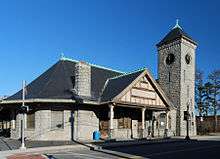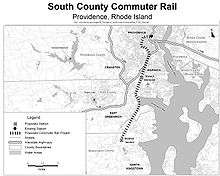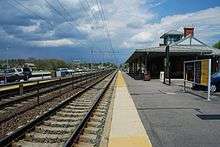Providence/Stoughton Line
The Providence/Stoughton Line is a line of the MBTA Commuter Rail system running southwest from Boston, Massachusetts, USA. The main line was originally built by the Boston and Providence Railroad, and now carries commuter trains between South Station in Boston and Wickford Junction station in North Kingstown, Rhode Island. The Stoughton Branch, built as the Stoughton Branch Railroad, splits at Canton Junction and runs for two more stations to Stoughton station in Stoughton, Massachusetts.
| Providence/Stoughton Line | |||||||||||||||||||||||||||||||||||||||||||||||||||||||||||||||||||||||||||||||||||||||||||||||||||||||||||||||||||||||||||||||||||||||||||||||||||||||||||||||||||||||||||||||||||||||||||||||||||||||||||||||||||||||||||||||||||||||||||||||||||||||||||||||||||||||||||||||||||||||||||||||||||||||||||||||||||||||||||||||||||||||||||||||||||||||||||||||||||||||||||||||||||||||||||||||||||||||||||||||||||
|---|---|---|---|---|---|---|---|---|---|---|---|---|---|---|---|---|---|---|---|---|---|---|---|---|---|---|---|---|---|---|---|---|---|---|---|---|---|---|---|---|---|---|---|---|---|---|---|---|---|---|---|---|---|---|---|---|---|---|---|---|---|---|---|---|---|---|---|---|---|---|---|---|---|---|---|---|---|---|---|---|---|---|---|---|---|---|---|---|---|---|---|---|---|---|---|---|---|---|---|---|---|---|---|---|---|---|---|---|---|---|---|---|---|---|---|---|---|---|---|---|---|---|---|---|---|---|---|---|---|---|---|---|---|---|---|---|---|---|---|---|---|---|---|---|---|---|---|---|---|---|---|---|---|---|---|---|---|---|---|---|---|---|---|---|---|---|---|---|---|---|---|---|---|---|---|---|---|---|---|---|---|---|---|---|---|---|---|---|---|---|---|---|---|---|---|---|---|---|---|---|---|---|---|---|---|---|---|---|---|---|---|---|---|---|---|---|---|---|---|---|---|---|---|---|---|---|---|---|---|---|---|---|---|---|---|---|---|---|---|---|---|---|---|---|---|---|---|---|---|---|---|---|---|---|---|---|---|---|---|---|---|---|---|---|---|---|---|---|---|---|---|---|---|---|---|---|---|---|---|---|---|---|---|---|---|---|---|---|---|---|---|---|---|---|---|---|---|---|---|---|---|---|---|---|---|---|---|---|---|---|---|---|---|---|---|---|---|---|---|---|---|---|---|---|---|---|---|---|---|---|---|---|---|---|---|---|---|---|---|---|---|---|---|---|---|---|---|---|---|---|---|---|---|---|---|---|---|---|---|---|---|---|---|---|---|---|---|---|---|---|---|---|---|---|---|---|---|---|---|---|---|---|---|---|---|---|---|---|---|---|---|---|---|---|---|---|---|---|---|---|---|---|---|
An outbound Providence/Stoughton Line train at Route 128 station | |||||||||||||||||||||||||||||||||||||||||||||||||||||||||||||||||||||||||||||||||||||||||||||||||||||||||||||||||||||||||||||||||||||||||||||||||||||||||||||||||||||||||||||||||||||||||||||||||||||||||||||||||||||||||||||||||||||||||||||||||||||||||||||||||||||||||||||||||||||||||||||||||||||||||||||||||||||||||||||||||||||||||||||||||||||||||||||||||||||||||||||||||||||||||||||||||||||||||||||||||||
| Overview | |||||||||||||||||||||||||||||||||||||||||||||||||||||||||||||||||||||||||||||||||||||||||||||||||||||||||||||||||||||||||||||||||||||||||||||||||||||||||||||||||||||||||||||||||||||||||||||||||||||||||||||||||||||||||||||||||||||||||||||||||||||||||||||||||||||||||||||||||||||||||||||||||||||||||||||||||||||||||||||||||||||||||||||||||||||||||||||||||||||||||||||||||||||||||||||||||||||||||||||||||||
| System | MBTA Commuter Rail | ||||||||||||||||||||||||||||||||||||||||||||||||||||||||||||||||||||||||||||||||||||||||||||||||||||||||||||||||||||||||||||||||||||||||||||||||||||||||||||||||||||||||||||||||||||||||||||||||||||||||||||||||||||||||||||||||||||||||||||||||||||||||||||||||||||||||||||||||||||||||||||||||||||||||||||||||||||||||||||||||||||||||||||||||||||||||||||||||||||||||||||||||||||||||||||||||||||||||||||||||||
| Status | Operating | ||||||||||||||||||||||||||||||||||||||||||||||||||||||||||||||||||||||||||||||||||||||||||||||||||||||||||||||||||||||||||||||||||||||||||||||||||||||||||||||||||||||||||||||||||||||||||||||||||||||||||||||||||||||||||||||||||||||||||||||||||||||||||||||||||||||||||||||||||||||||||||||||||||||||||||||||||||||||||||||||||||||||||||||||||||||||||||||||||||||||||||||||||||||||||||||||||||||||||||||||||
| Locale | Southeastern Massachusetts Rhode Island | ||||||||||||||||||||||||||||||||||||||||||||||||||||||||||||||||||||||||||||||||||||||||||||||||||||||||||||||||||||||||||||||||||||||||||||||||||||||||||||||||||||||||||||||||||||||||||||||||||||||||||||||||||||||||||||||||||||||||||||||||||||||||||||||||||||||||||||||||||||||||||||||||||||||||||||||||||||||||||||||||||||||||||||||||||||||||||||||||||||||||||||||||||||||||||||||||||||||||||||||||||
| Termini | South Station Wickford Junction or Stoughton | ||||||||||||||||||||||||||||||||||||||||||||||||||||||||||||||||||||||||||||||||||||||||||||||||||||||||||||||||||||||||||||||||||||||||||||||||||||||||||||||||||||||||||||||||||||||||||||||||||||||||||||||||||||||||||||||||||||||||||||||||||||||||||||||||||||||||||||||||||||||||||||||||||||||||||||||||||||||||||||||||||||||||||||||||||||||||||||||||||||||||||||||||||||||||||||||||||||||||||||||||||
| Stations | 15 | ||||||||||||||||||||||||||||||||||||||||||||||||||||||||||||||||||||||||||||||||||||||||||||||||||||||||||||||||||||||||||||||||||||||||||||||||||||||||||||||||||||||||||||||||||||||||||||||||||||||||||||||||||||||||||||||||||||||||||||||||||||||||||||||||||||||||||||||||||||||||||||||||||||||||||||||||||||||||||||||||||||||||||||||||||||||||||||||||||||||||||||||||||||||||||||||||||||||||||||||||||
| Daily ridership | 25,728 (2018)[1] | ||||||||||||||||||||||||||||||||||||||||||||||||||||||||||||||||||||||||||||||||||||||||||||||||||||||||||||||||||||||||||||||||||||||||||||||||||||||||||||||||||||||||||||||||||||||||||||||||||||||||||||||||||||||||||||||||||||||||||||||||||||||||||||||||||||||||||||||||||||||||||||||||||||||||||||||||||||||||||||||||||||||||||||||||||||||||||||||||||||||||||||||||||||||||||||||||||||||||||||||||||
| Operation | |||||||||||||||||||||||||||||||||||||||||||||||||||||||||||||||||||||||||||||||||||||||||||||||||||||||||||||||||||||||||||||||||||||||||||||||||||||||||||||||||||||||||||||||||||||||||||||||||||||||||||||||||||||||||||||||||||||||||||||||||||||||||||||||||||||||||||||||||||||||||||||||||||||||||||||||||||||||||||||||||||||||||||||||||||||||||||||||||||||||||||||||||||||||||||||||||||||||||||||||||||
| Owner | MBTA (within Massachusetts) Amtrak (within Rhode Island) | ||||||||||||||||||||||||||||||||||||||||||||||||||||||||||||||||||||||||||||||||||||||||||||||||||||||||||||||||||||||||||||||||||||||||||||||||||||||||||||||||||||||||||||||||||||||||||||||||||||||||||||||||||||||||||||||||||||||||||||||||||||||||||||||||||||||||||||||||||||||||||||||||||||||||||||||||||||||||||||||||||||||||||||||||||||||||||||||||||||||||||||||||||||||||||||||||||||||||||||||||||
| Operator(s) | Keolis North America | ||||||||||||||||||||||||||||||||||||||||||||||||||||||||||||||||||||||||||||||||||||||||||||||||||||||||||||||||||||||||||||||||||||||||||||||||||||||||||||||||||||||||||||||||||||||||||||||||||||||||||||||||||||||||||||||||||||||||||||||||||||||||||||||||||||||||||||||||||||||||||||||||||||||||||||||||||||||||||||||||||||||||||||||||||||||||||||||||||||||||||||||||||||||||||||||||||||||||||||||||||
| Technical | |||||||||||||||||||||||||||||||||||||||||||||||||||||||||||||||||||||||||||||||||||||||||||||||||||||||||||||||||||||||||||||||||||||||||||||||||||||||||||||||||||||||||||||||||||||||||||||||||||||||||||||||||||||||||||||||||||||||||||||||||||||||||||||||||||||||||||||||||||||||||||||||||||||||||||||||||||||||||||||||||||||||||||||||||||||||||||||||||||||||||||||||||||||||||||||||||||||||||||||||||||
| Line length | 62.9 miles (101.2 km) (South Station–Wickford Junction) 18.9 miles (30.4 km) (South Station–Stoughton)[2] | ||||||||||||||||||||||||||||||||||||||||||||||||||||||||||||||||||||||||||||||||||||||||||||||||||||||||||||||||||||||||||||||||||||||||||||||||||||||||||||||||||||||||||||||||||||||||||||||||||||||||||||||||||||||||||||||||||||||||||||||||||||||||||||||||||||||||||||||||||||||||||||||||||||||||||||||||||||||||||||||||||||||||||||||||||||||||||||||||||||||||||||||||||||||||||||||||||||||||||||||||||
| Track gauge | 4 ft 8 1⁄2 in (1,435 mm) | ||||||||||||||||||||||||||||||||||||||||||||||||||||||||||||||||||||||||||||||||||||||||||||||||||||||||||||||||||||||||||||||||||||||||||||||||||||||||||||||||||||||||||||||||||||||||||||||||||||||||||||||||||||||||||||||||||||||||||||||||||||||||||||||||||||||||||||||||||||||||||||||||||||||||||||||||||||||||||||||||||||||||||||||||||||||||||||||||||||||||||||||||||||||||||||||||||||||||||||||||||
| |||||||||||||||||||||||||||||||||||||||||||||||||||||||||||||||||||||||||||||||||||||||||||||||||||||||||||||||||||||||||||||||||||||||||||||||||||||||||||||||||||||||||||||||||||||||||||||||||||||||||||||||||||||||||||||||||||||||||||||||||||||||||||||||||||||||||||||||||||||||||||||||||||||||||||||||||||||||||||||||||||||||||||||||||||||||||||||||||||||||||||||||||||||||||||||||||||||||||||||||||||
An extension of the Providence section of the line to T. F. Green Airport and Wickford Junction opened in stages in 2010 and 2012, making the Providence/Stoughton Line the longest of the MBTA's commuter rail lines (surpassing the Fitchburg Line), while an extension of the Stoughton Branch to New Bedford and Fall River is under construction.
All stations are handicapped accessible with short or full-length high level platforms. Newer stations like T.F. Green Airport, and Amtrak stations like Providence, usually have full-length high level platforms; older stations have mostly been retrofitted with high-level platforms one car length long. The line is the busiest on the MBTA Commuter Rail system, with 25,728 daily boardings by a 2018 count.[1]
History

On December 31, 1968, the recently formed Penn Central bought the failing New York, New Haven and Hartford Railroad. The MBTA bought the section of the Providence–Boston line in Massachusetts, as well as many other lines including the Stoughton Branch, from Penn Central on January 27, 1973. On April 1, 1976 Conrail took over Penn Central and the commuter rail equipment was sold to the MBTA, though operation continued to be done by Conrail. Full subsidies by the MBTA for the Providence and Stoughton lines began on September 28, 1976, before which the Federal government helped. On March 31, 1977, the Greater Attleboro Taunton Regional Transit Authority and Rhode Island Department of Transportation began to subsidize service beyond the MBTA district, and Stoughton began to pay to keep its station open, that cost later going to the Brockton Area Transit Authority.
On November 3, 1979, the line was closed north of Readville for long-term reconstruction as part of the Southwest Corridor project. All trains began using what is now the Fairmount Line, and special shuttle trains connected South Station to Back Bay. The new line, rebuilt below grade with space for three tracks (the old one had been above grade with room for four tracks), opened on October 5, 1987.[3] The Orange Line shares the corridor between Back Bay and Forest Hills.
In 1990, a northbound commuter train was involved in a collision with a northbound Night Owl train. The accident, which occurred to the west of Back Bay station, injured over four hundred people, although there were no fatalities.[4]
On February 20, 1981, the MBTA stopped serving Rhode Island, as funding from the state had ended. On September 17, 1986, the two states reached an agreement to resume service.[5] Rush-hour service was restored on February 1, 1988. On June 20, 1990, a new stop opened in South Attleboro and most trains were extended to the station; regular Sunday service returned in 1992.[3] Some off-peak weekday trains were extended to Providence starting on December 11, 2000.[3] On July 24, 2006, the MBTA increased weekday Providence from 11 to 15 daily round trips. Weekend service to Providence resumed on July 29, and a new layover facility was opened in Pawtucket.[6][7][8]
Amtrak electrified the Providence Line in 2000, but the MBTA has not utilized this. In 2019, the MBTA had preliminary discussions with Amtrak about leasing Siemens ACS-64 electric locomotives to test on the Providence Line.[9]
Extensions

As part of the South County Commuter Rail initiative, a 20-mile extension past Providence to T. F. Green Airport and Wickford Junction in Rhode Island is now fully open. The T. F. Green Airport part of the extension opened in December 2010, with Wickford Junction service beginning in April 2012.[10]
A further 24-mile extension is under consideration by the Rhode Island Department of Transportation. Possible stops include Cranston and East Greenwich, plus existing Amtrak stations in Kingston and Westerly and a possible revival of the Pawtucket/Central Falls station. Rhode Island eventually plans to have its own statewide commuter service along the Northeast Corridor that would connect with MBTA service and an extension of Shore Line East.[11] This would be the first commuter service to Westerly since the last state-sponsored train was run in December 1979.[3] A passing siding (currently under construction) and new platforms (planned) at Kingston may enable extension of some trains there in the near term.[12]
The Stoughton branch is currently being extended to Taunton, Fall River, and New Bedford under a proposed project called South Coast Rail, under which it would operate as a separate line rather than a branch of the Providence Line. Track has been bought from CSX, but construction has not yet begun on stations.
Ownership and financing
The MBTA owns the track from Boston to the Rhode Island border. Track in Rhode Island is owned by Amtrak. The entire line is part of the Northeast Corridor.
As part of the 1988[13] Pilgrim Partnership Agreement, Rhode Island provides capital funding (including some of its federal formula funds) for MBTA expansion in the state. Massachusetts (through the MBTA) provides the operating subsidy for MBTA Commuter Rail service in return.[14] Rhode Island also pays Amtrak to allow the MBTA to use its tracks.[15]
Station listing

| State | Fare zone | Location | Mile (km)[2][16] | Station | Connections and notes |
|---|---|---|---|---|---|
| MA | 1A | Boston | 0.0 (0.0) | ||
| 1.2 (1.9) | |||||
| 2.2 (3.5) | |||||
| 5.0 (8.0) | Served by Needham Line and Orange Line trains only | ||||
| 6.5 (10.5) | Mount Hope | Closed November 2, 1979 | |||
| 1 | 8.4 (13.5) | ||||
| 2 | 9.5 (15.3) | Served by Fairmount Line and Franklin Line trains only | |||
| Westwood | 11.4 (18.3) | ||||
| 3 | Canton | 14.8 (23.8) | Split with Stoughton Branch | ||
| 4 | Sharon | 17.9 (28.8) | |||
| Foxborough | 23.0 (37.0) | East Foxboro | Closed November 1977 | ||
| 6 | Mansfield | 24.7 (39.8) | |||
| 7 | Attleboro | 31.8 (51.2) | |||
| 36.8 (59.2) | |||||
| RI | Pawtucket | 39.0 (62.8) | Pawtucket/Central Falls | Closed February 19, 1981, planned replacement station to be located 0.5 miles (0.80 km) south | |
| 8 | Providence | 43.6 (70.2) | |||
| 9 | Warwick | 51.9 (83.5) | |||
| 10 | North Kingstown | 62.9 (101.2) | |||
| Currently operating station | |||||
Stoughton Branch
| State | Fare zone | Location | Mile (km)[2] | Station | Connections and notes |
|---|---|---|---|---|---|
| MA | 3 | Canton | 15.0 (24.1) | Splits from main line (Northeast Corridor) | |
| 15.6 (25.1) | |||||
| 4 | Stoughton | 18.9 (30.4) | |||
| Currently operating station | |||||
References
- "Commuter Rail Ridership Counts" (PDF). Massachusetts Bay Transportation Authority. January 28, 2019.
- "Ridership and Service Statistics" (PDF) (14th ed.). Massachusetts Bay Transportation Authority. 2014.
- Belcher, Jonathan. "Changes to Transit Service in the MBTA district" (PDF). NETransit.
- "Railroad Accident Report RAR-92-01: Derailment and Collision of Amtrak Passenger Train 66 with MBTA Commuter Train 906 at Back Bay Station, Boston, Massachusetts, December 12, 1990" (PDF). National Transportation Safety Board, Washington, DC. 25 February 1992.
- Sanborn, George M. (1992). A Chronicle of the Boston Transit System. Massachusetts Bay Transportation Authority – via Massachusetts Institute of Technology.
- "MBTA Expanding Train Service To Providence On Weekdays, Introducing New Service On Weekends" (Press release). Massachusetts Bay Transportation Authority. July 14, 2006.
- Castellucci, John (25 April 2006). "Planned rail yard will expand routes, relieve neighbors". Providence Journal. Archived from the original on 24 September 2009.
- "MBTA, U.S. Senator Jack Reed, RI Governor Carcieri, RIDOT Officially Open Pawtucket Layover Facility" (Press release). Massachusetts Bay Transportation Authority. August 2, 2006.
- Vaccaro, Adam (March 21, 2019). "Take the E-train? MBTA mulling electric locomotives". Boston Globe.
- Samantha, Turner (4 November 2010). "Commuter Rail Station To Open In 2012". North Kingston Patch. Archived from the original on 25 April 2012. Retrieved 2 October 2011.
- Edwards and Kelcey, Inc (July 2001). "South County Commuter Rail Service: Operations Plan" (PDF). Rhode Island Department of Transportation. Archived from the original (PDF) on 16 April 2009. Retrieved 2 October 2011.
- Barrett, Chris (31 December 2009). "Kingston MBTA stop project proposed". Providence Business News. Retrieved 8 April 2013.
- "COMMUTER RAIL SERVICE TO WARWICK'S T.F. GREEN STATION UNDERWAY". Massachusetts Bay Transportation Authority. 8 December 2010. Retrieved 2 October 2011.
- "South County Commuter Rail". Federal Transit Administration. 2011. Archived from the original on 27 September 2011. Retrieved 2 October 2011.
- Bierman, Noah (10 September 2009). "Vote set on T link to R.I. airport". Boston Globe. Retrieved 2 October 2011.
- Held, Patrick R. (2010). "Massachusetts Bay Colony Railroad Track Charts" (PDF). Johns Hopkins Association for Computing Machinery. Archived from the original (PDF) on 8 October 2013. Retrieved 2 February 2012.
External links
| Wikimedia Commons has media related to MBTA Providence/Stoughton Line. |